| Listing 1 - 9 of 9 |
Sort by
|
Book
ISBN: 9781644530771 1644530775 9781644530757 Year: 2013 Publisher: Newark
Abstract | Keywords | Export | Availability | Bookmark
 Loading...
Loading...Choose an application
- Reference Manager
- EndNote
- RefWorks (Direct export to RefWorks)
English drama --- Prologues and epilogues --- Theater --- History and criticism. --- History
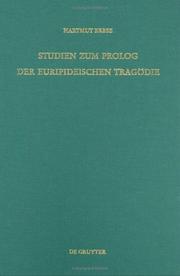
ISBN: 3110100002 311084950X 9783110100006 Year: 1984 Volume: 20 Publisher: Berlin de Gruyter
Abstract | Keywords | Export | Availability | Bookmark
 Loading...
Loading...Choose an application
- Reference Manager
- EndNote
- RefWorks (Direct export to RefWorks)
Euripides --- Prologues and epilogues --- Mythology, Greek, in literature --- Tragedy --- History and criticism --- Technique --- -Tragedy --- Drama --- Epilogues --- Postscripts (Epilogues) --- Prefaces --- -Technique --- Mythology, Greek, in literature. --- Tragedy. --- History and criticism. --- Technique. --- -Euripides --- Euripide --- Euripide. Prologues. --- Euripides. Prologen. --- Ėvripid --- Yūrībīdīs --- Euripedes --- Eŭripido --- Eurypides --- Euripidesu --- אוריפידס --- エウリーピデース --- Εὐριπίδης --- Prologues and epilogues - History and criticism --- Euripides - Technique
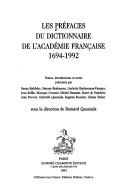
ISSN: 12798207 ISBN: 2852038188 9782852038189 Year: 1997 Volume: 1 Publisher: Paris Champion
Abstract | Keywords | Export | Availability | Bookmark
 Loading...
Loading...Choose an application
- Reference Manager
- EndNote
- RefWorks (Direct export to RefWorks)
French language --- anno 1700-1799 --- anno 1900-1999 --- anno 1800-1899 --- anno 1600-1699 --- Prefaces --- 804.0 --- Academie francaise --- Prologues and epilogues --- Frans. Franse taalkunde --- 804.0 Frans. Franse taalkunde --- Académie française. --- Dictionnaire
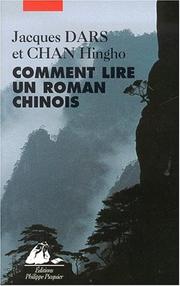
ISBN: 2877305252 Year: 2001 Publisher: Arles Éditions Philippe Picquier
Abstract | Keywords | Export | Availability | Bookmark
 Loading...
Loading...Choose an application
- Reference Manager
- EndNote
- RefWorks (Direct export to RefWorks)
S16/0400 --- S16/0180 --- S16/0195 --- Chinese fiction --- -Prefaces --- Prologues and epilogues --- Chinese literature --- China: Literature and theatrical art--Traditional novels: studies --- China: Literature and theatrical art--Stylistics --- China: Literature and theatrical art--Thematic studies --- History and criticism --- Prefaces --- Fiction
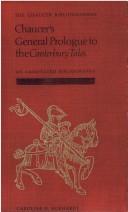
ISBN: 1282009893 9786612009891 1442672870 9781442672871 0802025927 9780802025920 0802006264 Year: 1990 Publisher: Toronto
Abstract | Keywords | Export | Availability | Bookmark
 Loading...
Loading...Choose an application
- Reference Manager
- EndNote
- RefWorks (Direct export to RefWorks)
The General Prologue to Chaucer's Canterbury Tales is one of the most enduring works of English literature. Beloved by scholars, teachers, students, and general readers, it has been given a great many different interpretations. This annotated, international bibliography of twentieth-century criticism on the Prologue is an essential reference guide. It includes books, journal articles, and dissertations, and a descriptive list of twentieth-century editions; it is the most complete inventory of modern criticism on the Prologue. The extensive annotations provide uniquely convenient access to many publications that are otherwise difficult to obtain.In her introduction, Caroline Eckhardt provides a careful and comprehensive overview of modern trends in criticism, trends which can be traced through the bibliography. At the beginning of the century, for example, Chaucer's Prologue was often described as a 'portrait gallery' and praised for its realism - social, psychological, and dramatic. Later in the century came emphases on irony, rhetoric, Freudian interpretations, elaborate allegories, and stylistic complexities. At present, the Prologue is often interpreted as a system of signs and symbols in which realism, if it exists at all, serves purposes beyond itself. The smiling and serene poet of the earlier period has been replaced by a self-conscious ironist, sometimes with a split personality. The portrait gallery of the beginning of the century is still there, though the spectator who walks along it tends to see something less fixed textually (the Prologue is now commonly discussed as work-in-progress) and more complicated structurally, generically, and thematically. It is the spectator, of course, who has changed.
Christian pilgrims and pilgrimages in literature --- English poetry --- Civilization, Medieval, in literature --- Prologues and epilogues --- Epilogues --- Postscripts (Epilogues) --- Prefaces --- Chaucer, Geoffrey, --- Canterbury tales (Chaucer, Geoffrey) --- Caxton's Chaucer (Chaucer, Geoffrey)
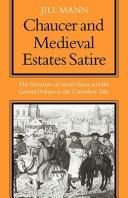
ISBN: 052120058X 0521097959 0511552971 0511864477 9780521200585 9780511552977 9780521097956 Year: 1973 Publisher: Cambridge
Abstract | Keywords | Export | Availability | Bookmark
 Loading...
Loading...Choose an application
- Reference Manager
- EndNote
- RefWorks (Direct export to RefWorks)
This book is an attempt to discover the origins and significance of the General Prologue-to the Canterbury Tales. The interest of such an inquiry is many-sided. On the one hand, it throws light on the question of whether `life' or 'literature' was Chaucer's model in this work, on the relationship between Chaucer's twenty-odd pilgrims and the structure of medieval society, and on the role of their `estate' in determining the elements of which Chaucer composes their portraits. On the other hand, it makes suggestions about the ways in which Chaucer convinces us of the individuality of his pilgrims, about the nature of his irony, and the kind of moral standards implicit in the Prologue. This book suggests that Chaucer is ironically substituting for the traditional moral view of social structure a vision of a world where morality becomes as specialised to the individual as his work-life.
Chaucer, Geoffrey --- Estates (Social orders) --- Prologues and epilogues --- Christian pilgrims and pilgrimages in literature --- Satire, Medieval --- Tales, Medieval --- Social history --- Social problems in literature --- Social classes in literature --- Satire --- History --- History and criticism --- Religious aspects --- Chaucer, Geoffrey, --- Political and social views --- -Social classes in literature --- -Social problems in literature --- -Satire --- -Prologues and epilogues --- -Estates (Social orders) --- -Descriptive sociology --- Social conditions --- Sociology --- Medieval satire --- Commons (Social order) --- Feudalism --- Epilogues --- Postscripts (Epilogues) --- Prefaces --- Comic literature --- Literature --- Wit and humor --- Invective --- Medieval tales --- -Chaucer, Geoffrey --- -Political and social views --- -History and criticism --- Christian pilgrims and pilgrimages in literature. --- Social problems in literature. --- Social classes in literature. --- History and criticism. --- Religious aspects. --- Political and social views. --- -Commons (Social order) --- Descriptive sociology --- Chaucer, Jeffrey, --- Chʻiao-sou, Chieh-fu-lei, --- Chieh-fu-lei Chʻiao-sou, --- Choser, Dzheffri, --- Choser, Zheoffreĭ, --- Cosvr, Jvoffrvi, --- Tishūsar, Zhiyūfrī, --- Arts and Humanities --- Estates (Social orders) - England - History - To 1500 --- Prologues and epilogues - History and criticism --- Satire, Medieval - History and criticism --- Tales, Medieval - History and criticism --- Social history - Medieval, 500-1500 --- Satire - Religious aspects --- Chaucer, Geoffrey, - -1400 - Canterbury tales - Prologue --- Chaucer, Geoffrey, - -1400 - Political and social views --- CHAUCER (GEOFFREY), d. 1400 --- LITERATURE AND SOCIETY --- CANTERBURY TALES --- PROLOGUE --- ENGLAND --- Chaucer, Geoffrey, - -1400
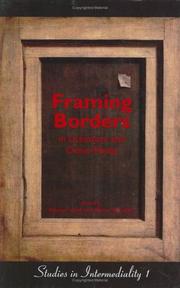
ISBN: 9042017899 9789042017894 9401202028 1423791088 9781423791089 9789401202022 Year: 2006 Volume: 1 Publisher: Amsterdam New York Rodopi
Abstract | Keywords | Export | Availability | Bookmark
 Loading...
Loading...Choose an application
- Reference Manager
- EndNote
- RefWorks (Direct export to RefWorks)
This book is both a contribution to an interdisciplinary study of literature and other media and a pioneering application of cognitive and frame-theoretical approaches to these fields. In the temporal media a privileged place for the coding of cognitive frames are the beginnings while in spatial media physical borders take over many framing functions. This volume investigates forms and functions of such framing spaces from a transmedial perspective by juxtaposing and comparing the framing potential of individual media and works. After an introductory theoretical essay, which aims to clarify basic concepts, the volume presents eighteen contributions by scholars from various disciplines who deal with individual media. The first section is dedicated to framing in or through the visual arts and includes discussions of the illustrations of medieval manuscripts, the practice of framing pictures from the Middle Ages to Magritte and contemporary American art as well as framings in printmaking and architecture. The second part deals with literary texts and ranges from studies centred on framings in frame stories to essays focussing on the use of paratextual, textual and non-verbal media in the framings of classical, medieval and modern German and American narrative literature; moreover, it includes studies on defamiliarized framings, e.g. by Julio Cortázar and Jasper Fforde, as well as an essay on end-framing practices. Sections on framings in film (including the trailers of Tolkien's The Lord of the Rings ) and in music (operatic overtures and Schumann's piano pieces) provide perspectives on further media. The volume is of relevance to students and scholars from various fields: intermedia studies, cognitive approaches to the media, literary and film studies, history of art, and musicology.
Arts --- Borders, Ornamental (Decorative arts) --- Boundaries in literature --- Film. --- Frame-stories --- Intermedialität. --- Kunst. --- Literatur. --- Motion pictures --- Music --- Musik. --- Rahmen. --- Ästhetik. --- Psychological aspects --- Aesthetics --- Philosophy and aesthetics --- Graz --- Bordures (Arts décoratifs) --- Frontières dans la littérature --- Récits enchâssés --- Cinéma --- Musique --- Congresses. --- Aspect psychologique --- Congrès --- Esthétique --- Philosophie et esthétique --- Cinema --- Feature films --- Films --- Movies --- Moving-pictures --- Audio-visual materials --- Mass media --- Performing arts --- Prologues and epilogues --- Short story --- Tales --- Ornamental borders (Decorative arts) --- Decoration and ornament --- Arts, Fine --- Arts, Occidental --- Arts, Western --- Fine arts --- Humanities --- History and criticism --- Arts, Primitive
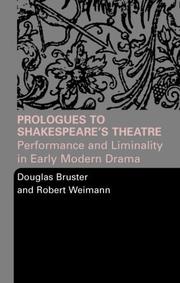
ISBN: 1134313713 1280177772 0203362683 9780203362686 041533442X 0415334438 9780415334426 9781134313662 9781134313709 9781134313716 9780415334433 1134313705 Year: 2004 Publisher: London Routledge
Abstract | Keywords | Export | Availability | Bookmark
 Loading...
Loading...Choose an application
- Reference Manager
- EndNote
- RefWorks (Direct export to RefWorks)
This remarkable study shows how prologues ushered audience and actors through a rite of passage and how they can be seen to offer rich insight into what the early modern theatre was thought capable of achieving.
English drama --- Prologues and epilogues --- Mimesis in literature. --- Drama --- Openings (Rhetoric) --- Beginnings (Rhetoric) --- First lines (Rhetoric) --- Opening sentences --- Rhetoric --- Dramaturgy --- Authorship --- Playwriting --- Representation (Literature) --- Imitation in literature --- Realism in literature --- History and criticism. --- Technique. --- Shakespeare, William, --- Shakespeare, William --- Shakespear, William, --- Shakspeare, William, --- Šekʻspiri, Uiliam, --- Saixpēr, Gouilliam, --- Shakspere, William, --- Shikisbīr, Wilyam, --- Szekspir, Wiliam, --- Šekspyras, --- Shekspir, Vilʹi︠a︡m, --- Šekspir, Viljem, --- Tsikinya-chaka, --- Sha-shih-pi-ya, --- Shashibiya, --- Sheḳspir, Ṿilyam, --- Shaḳspir, Ṿilyam, --- Syeiksŭpʻio, --- Shekspir, V. --- Szekspir, William, --- Shakespeare, Guglielmo, --- Shake-speare, William, --- Sha-ō, --- Şekspir, --- Shekspir, Uiliam, --- Shekspir, U. --- Šekspir, Vilijam, --- Ṣēkspiyar, Viliyam, --- Shakspir, --- Shekspyr, Vyli︠e︡m, --- Şekspir, Velyam, --- Ṣēkspiyar, Villiyam, --- Shēkʻspʻiyr, Vlilliam, --- Ṣēkspiyar, --- Ṣēkspiyar Mahākavi, --- Ṣēkspiyar Mahākaviya, --- Sheḳspier, Ṿilyam, --- Shēkʻspir, --- Shakespeare, --- Śeksper, --- Шекспир, Вильям, --- Шекспир, Уильям, --- שייקספיר, וויליאם, --- שייקספיר, וו., --- שיקספיר, וויליאם --- שיקספיר, ויליאם --- שיקספיר, ויליאם, --- שכספיר, ויליאם, --- שכספיר, וילים, --- שכספיר, ו׳ --- שעפקספיר, וויליאם, --- שעקספיער, וויליאם --- שעקספיער, וויליאם, --- שעקספיער, ווילליאם --- שעקספיער, וו., --- שעקספיר --- שעקספיר, וו --- שעקספיר, וויליאם, --- שעקספיר, וויליאמ --- שעקספיר, ווילליאם --- שעקספיר, ווילליאם, --- שעקספיר, וו., --- שעקספיר, װיליאם, --- שעקספיר, װילליאם, --- שעקספיר, װ., --- שעקספער --- שעקספער, וויליאמ --- שקספיר --- שקספיר, וו --- שקספיר, וויליאם --- שקספיר, וויליאם, --- שקספיר, ווילים, --- שקספיר, וילאם --- שקספיר, ויליאם --- שקספיר, ויליאם, --- שקספיר, ויליים, --- שקספיר, וילים --- שקספיר, וילים, --- شاكسبير، وليم --- شاكسپير، وليم --- شكسبير، وليام --- شكسبير، وليم --- شكسبير، وليم، --- شكسبير، و. --- شكسپير، وليم --- شكسپير، ويليام --- شيكسبير، وليام --- شيكسبير، وليام.، --- شيكسبير، وليم --- شکسبير، وليم --- وليم شکسبير --- 沙士北亞威廉姆, --- 沙士比亞威廉姆, --- 莎士比亞威廉姆, --- 莎士比亞威廉, --- 莎士比亞,
Book
ISBN: 1684480663 9781684480661 1684480531 1684480523 Year: 2019 Publisher: Lewisburg, PA
Abstract | Keywords | Export | Availability | Bookmark
 Loading...
Loading...Choose an application
- Reference Manager
- EndNote
- RefWorks (Direct export to RefWorks)
"In this incisive, original book, S. Williams reads prefaces to German literature and philosophy around 1800 as pretexts for writing, examining three of the most remarkable preface-writers of that era--Goethe, Jean Paul, and Hegel--in the contexts not only of German, but also European print culture, thought, and literature"-- "Around 1800, print culture became a particularly rich source for metaphors about thinking as well as writing, nowhere more so than in the German tradition of Dichter und Denker. Goethe, Jean Paul, and Hegel (among many others) used the preface in order to reflect on the problems of writing itself, and its interpretation. If Sterne teaches us that a material book enables mind games as much as it gives expression to them, the Germans made these games more theoretical still. Weaving in authors from Antiquity to Agamben, Williams shows how European-and, above all, German-Romanticism was a watershed in the history of the preface. The playful, paradoxical strategies that Romantic writers invented are later played out in continental philosophy, and in post-Structuralist literature. The preface is a prompt for playful thinking with texts, as much as it is conventionally the prosaic product of such an exercise"--
German literature --- Prefaces --- History and criticism. --- Goethe, Johann Wolfgang von, --- Jean Paul, --- Hegel, Georg Wilhelm Friedrich, --- Hegel, Giorgio Guglielmo Frederico --- Hegel, Georg Wilhelm Friedrich --- Paul, Jean, --- Richter, Johann Paul Friedrich, --- Rikhter, Zhen Polʹ Friderik, --- Richter, Jean Paul, --- Goethe, Johann Wolfgang --- Goethe --- Goethe, Johann Wolfgang von --- Von Goethe, Johann Wolfgang --- von Goethe, Johann Wolfgang --- Hete, Johann Vol'fhanh --- Gete, Iogann Vol'fgang --- ゲーテ --- Gete, Volʹfgang --- Ko-tê --- Gede --- Gete, Jogann --- Gette --- Gʹote, Ĭokhan Volʹfgang --- Jūtah, Yūhān Fūlfjānj --- Goethe, J. W. --- Jītī --- Gete, V. --- Koetʻe --- Goetʻe --- Getė, --- Gkaite --- Gitah, Y. Ṿ. --- Goethe, Jan Wolfgan, --- Gëte, Iogann Volʹfgang --- Göte --- Gyoete --- Goethe, W. v. --- Fon-Geteh, Ṿ. --- Geteh, Yohan Ṿolfgang Fon --- -Giteh, Yohan Ṿolfgang Fon --- -Gete, Johan Volfgang --- Hete, Ĭ. V. --- Kēōtʻē, Volfkank --- Katē --- Katē, Yōkān̲ Vulpkēṅk Vān̲ --- Гете, Иоганн Вольфганг --- Qöte, Y. V. --- Qöte, Yohan Volfqanq --- גטה --- גטה, יוהאן וולפגנג פון, --- גטה, י.ו --- גיתה --- גיתה, יוהאן וולפאנג פון --- גיתה, יוהאן וולפגנג פון, --- גיתה, יוהן וולפגאנג וון, --- גיתה, יוהן וולפגנג פון, --- גיתה, יוהן וולפגנג, --- געטהע --- געטהע, יאהאן וואלפגאנג --- געטהע, יאהאן וואלפגאנג פון, --- געטהע, יאהאן װאלפגאנג, --- געטהע, י. וו --- געטהע, י. וו. פאן --- געטהע, י. װ., --- געטהע, י.װ --- געטע, װ.פ --- גתה, וו --- גתה, יוהן וולפגאנג ון, --- גתה, יוהן וולפגנג --- י. וו. געטהע --- جوته --- گوته، يوهان ولفگانگ ون --- 歌德, --- Criticism and interpretation. --- Prefaces. --- German literature. --- PHILOSOPHY / Aesthetics. --- LITERARY CRITICISM / Gothic & Romance. --- LITERARY CRITICISM / European / German. --- Prologues and epilogues --- Gede, --- Gëte, Iogann Volʹfgang, --- Gete, Jogann, --- Gete, Johan Volfgang, --- Gete, Volʹfgang, --- Gēte, Yohan Vorufugangu fon, --- Geteh, Yohan Ṿolfgang Fon-, --- Gette, --- Gitah, Y. Ṿ., --- Giteh, Yohan Ṿolfgang Fon-, --- Gkaite, --- Goetʻe, --- Goethe, --- Goethe, Jan Wolfgang, --- Göte, --- Gʹote, Ĭokhan Volʹfgang, --- Gyoete, --- Jītī, --- Jūtah, Yūhān Fūlfjānj, --- Katē, --- Katē, Yōkān̲ Vulpkēṅk Vān̲, --- Kēōtʻē, Volfkank, --- Ko-tê, --- Koetʻe, --- Qöte, Yohan Volfqanq, --- Von Goethe, Johann Wolfgang, --- Chenkel, --- Gegelʹ, Georg, --- Hegel, --- Hegel, G. W. F. --- Hegel, Guillermo Federico, --- Hegel, Jorge Guillermo Federico, --- Hēgeru, --- Hei Ge Er, --- Hei-ko-erh, --- Heyel, Georg Wilhelm Friedrich, --- Hīghil, --- Higil, Gʼūrg Vīlhim Frīdrīsh, --- Hījil, --- Khegel,
| Listing 1 - 9 of 9 |
Sort by
|

 Search
Search Feedback
Feedback About UniCat
About UniCat  Help
Help News
News